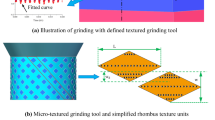Abstract
Simulation and grinding experiments on soda-lime glass were performed in this paper. The influence of grinding parameters on the grinding force, surface roughness, and morphology of soda-lime glass after processing was studied in this paper. The change in grinding force, processed surface morphology, and surface roughness after grinding of different coated micro-grinding tools was discussed. Simulation results and experimental results have the same trend. The conclusion shows that as the grinding speed increases, the grinding depth and feed speed decrease, the grinding force decreases, the machined surface roughness value decreases, the surface morphology is smoother, and the surface quality is better. Under different cooling conditions, the machined surface roughness value of wet grinding is lower, and the surface quality is better. The surface quality of diamond-coated micro-grinding tools is better, by comparing CBN-coated micro-grinding tools and diamond-coated micro-grinding tools of the same particle size, and it is more suitable for grinding hard and brittleness materials such as glass. The research results provide a theoretical reference and experimental basis for reducing the grinding force of coated micro-grinding tools and improving the quality and processing performance of the machined surface.































Similar content being viewed by others
Abbreviations
- K c :
-
Fracture toughness
- V :
-
Poisson’s ratio
- E :
-
Elastic modulus
- C 1 :
-
The transverse crack length
- C h :
-
The depth of the transverse crack
- α:
-
Semi-apex angle of abrasive grains
- F n :
-
Dimensionless constant
- L s :
-
The contact arc length
- v w :
-
Grinding speed
- v s :
-
Feed speed
- a p :
-
Grinding depth
References
Ruan MY, Zhang J, Peng XJ, Zhu XY (2021) Study on wear mechanism of nitrogen-Si coated ceramic cutters in cutting cast iron. J Mech Strength 43(01):101–106
Liu J, Zhu SS, Deng X (2021) Study on machining properties of dry turning Ti-6Al-4V titanium alloy with AlCrSin coated tool. Journal of Guangdong University of Technology 38(02):99–106
Ramana MV, Rao GKM, Sagar B, Panthang RK, Kumar BVRR (2021) Optimization of surface roughness and tool wear in sustainable dry turning of iron based nickel A286 alloy using Taguchi’s method. Clean Eng Technol 2:1–15
Banerjee T, Chattopadhyay AK (2020) Dry turning performance of TiN–WS;/TiN hard-lubricious bilayer composite coating. Mach Sci Technol 24(6):837–860
Rubio JCC, González AGG, Barcelos DJ, Câmara MA, Cabrera FM, Leite WDO (2021) Tribological analysis and performance of a DLC coating on tungsten carbide micro-tools to use at tantalum precision machining. Int J Adv Manuf Technol 116:719–732
Wang QQ, Jin ZJ, Zhao Y, Niu L, Guo J (2021) A comparative study on tool life and wear of uncoated and coated cutting tools in turning of tungsten heavy alloys. Wear 482:203929
Lubis S, Darmawan S, Indra B (2020) Tool wear analysis of coated carbide tools on cutting force in machining process of AISI 4140 steel. IOP Conf Ser: Mater Sci Eng 852:1–6
Wen XL, Cheng J (2019) Experimental study of a specially designed diamond micro discontinuous grinding tool. Int J Adv Manuf Technol 102:9–12
Zheng JX, Xu JW, Lv ZB (2006) Grinding mechanism of ceramics in the ductile regime. J Chin Ceram Soc 34:102–106
Li W, Li BZ, Yang JG (2017) Design and dynamic optimization of an ultra-precision micro grinding machine tool for flexible joint blade machining. Int J Adv Manuf Technol 93:9–12
Gong YD, Zhou YG, Wen XL, Cheng J, Sun Y, Ma LJ (2017) Experimental study on micro-grinding force and subsurface microstructure of nickel-based single crystal superalloy in micro grinding. J Mech Sci Technol 31(7):3397–3410
Aurich JC, Carrella M, Walk M (2015) Micro grinding with ultra small micro pencil grinding tools using an integrated machine tool. CIRP Ann 64:325–328
Díaz E, Pamparana G, Voisin L, Kracht W, Martínez P (2019) Exploring the effect of the geological texture at meso and micro scale on grinding performance. Miner Eng 144:1–15
Funding
The authors would like to thank the support of the National Natural Science Foundation of China (No. 52275412) and Fundamental Research Funds for the Central Universities (No. N2103023).
Author information
Authors and Affiliations
Contributions
All the authors listed have approved the manuscript that is enclosed.
Corresponding author
Ethics declarations
Conflict of interest
The authors declare no competing interest.
Additional information
Publisher’s note
Springer Nature remains neutral with regard to jurisdictional claims in published maps and institutional affiliations.
I would like to declare on behalf of my co-authors that the work described was original research that has not been published previously and is not under consideration for publication elsewhere, in whole or in part.
Rights and permissions
Springer Nature or its licensor (e.g. a society or other partner) holds exclusive rights to this article under a publishing agreement with the author(s) or other rightsholder(s); author self-archiving of the accepted manuscript version of this article is solely governed by the terms of such publishing agreement and applicable law.
About this article
Cite this article
Wen, X., Li, J. & Gong, Y. Simulation and experimental research on grinding force and grinding surface quality of TiC-coated micro-grinding tools. Int J Adv Manuf Technol 128, 1337–1351 (2023). https://doi.org/10.1007/s00170-023-11901-4
Received:
Accepted:
Published:
Issue Date:
DOI: https://doi.org/10.1007/s00170-023-11901-4




